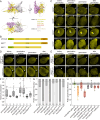Polarized subcellular activation of Rho proteins by specific ROPGEFs drives pollen germination in Arabidopsis thaliana
- PMID: 40258071
- PMCID: PMC12043234
- DOI: 10.1371/journal.pbio.3003139
Polarized subcellular activation of Rho proteins by specific ROPGEFs drives pollen germination in Arabidopsis thaliana
Abstract
During plant fertilization, excess male gametes compete for a limited number of female gametes. The dormant male gametophyte, encapsulated in the pollen grain, consists of two sperm cells enclosed in a vegetative cell. After reaching the stigma of a compatible flower, quick and efficient germination of the vegetative cell to a tip-growing pollen tube is crucial to ensure fertilization success. Rho of Plants (ROP) signaling and their activating ROP Guanine Nucleotide Exchange Factors (ROPGEFs) are essential for initiating polar growth processes in multiple cell types. However, which ROPGEFs activate pollen germination is unknown. We investigated the role of ROPGEFs in initiating pollen germination and the required cell polarity establishment. Of the five pollen-expressed ROPGEFs, we found that GEF8, GEF9, and GEF12 are required for pollen germination and male fertilization success, as gef8;gef9;gef12 triple mutants showed almost complete loss of pollen germination in vitro and had a reduced allele transmission rate. Live-cell imaging and spatiotemporal analysis of subcellular protein distribution showed that GEF8, GEF9, and GEF11, but not GEF12, displayed transient polar protein accumulations at the future site of pollen germination minutes before pollen germination, demonstrating specific roles for GEF8 and GEF9 during the initiation of pollen germination. Furthermore, this novel GEF accumulation appears in a biphasic temporal manner and can shift its location laterally. We showed that the C-terminal domain of GEF8 and GEF9 confers their protein accumulation and demonstrated that GEFs locally activate ROPs and alter Ca2+ levels, which is required for pollen tube germination. We demonstrated that not all GEFs act redundantly during pollen germination, and we described for the first time a polar domain with spatiotemporal flexibility, which is crucial for the de novo establishment of a polar growth domain within a cell and, thus, for pollen function and fertilization success.
Copyright: © 2025 Bouatta et al. This is an open access article distributed under the terms of the Creative Commons Attribution License, which permits unrestricted use, distribution, and reproduction in any medium, provided the original author and source are credited.
Conflict of interest statement
The authors have declared that no competing interests exist.
Figures




Similar articles
-
AGC1.5 Kinase Phosphorylates RopGEFs to Control Pollen Tube Growth.Mol Plant. 2018 Sep 10;11(9):1198-1209. doi: 10.1016/j.molp.2018.07.004. Epub 2018 Jul 25. Mol Plant. 2018. PMID: 30055264
-
Glycolysis regulates pollen tube polarity via Rho GTPase signaling.PLoS Genet. 2018 Apr 27;14(4):e1007373. doi: 10.1371/journal.pgen.1007373. eCollection 2018 Apr. PLoS Genet. 2018. PMID: 29702701 Free PMC article.
-
Arabidopsis RhoGDIs Are Critical for Cellular Homeostasis of Pollen Tubes.Plant Physiol. 2016 Feb;170(2):841-56. doi: 10.1104/pp.15.01600. Epub 2015 Dec 11. Plant Physiol. 2016. PMID: 26662604 Free PMC article.
-
Proteomics of pollen development and germination.J Proteome Res. 2007 Dec;6(12):4556-63. doi: 10.1021/pr070474y. Epub 2007 Oct 25. J Proteome Res. 2007. PMID: 17958392 Review.
-
Signaling network controlling ROP-mediated tip growth in Arabidopsis and beyond.Plant Commun. 2023 Jan 9;4(1):100451. doi: 10.1016/j.xplc.2022.100451. Epub 2022 Sep 15. Plant Commun. 2023. PMID: 36114666 Free PMC article. Review.
References
MeSH terms
Substances
LinkOut - more resources
Full Text Sources
Miscellaneous

